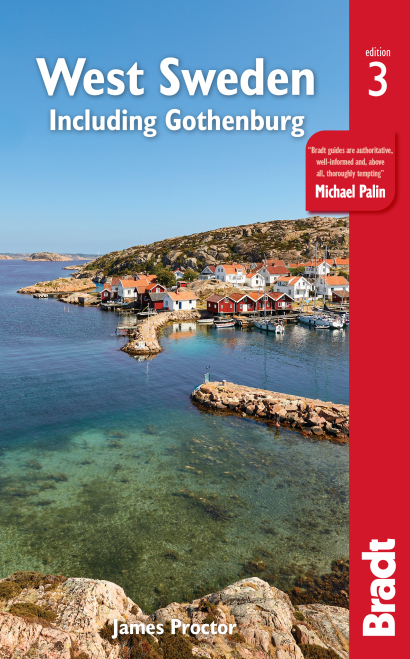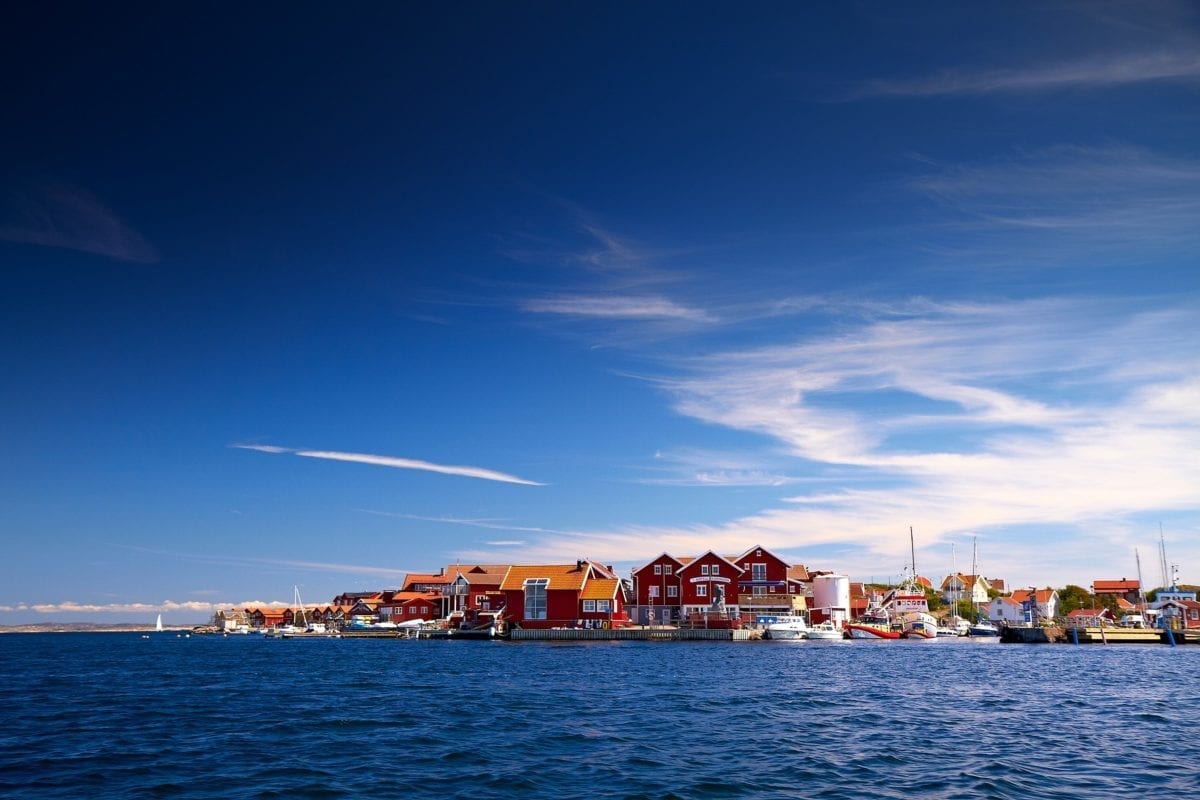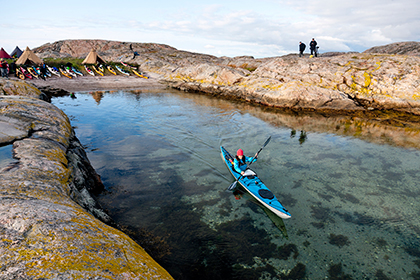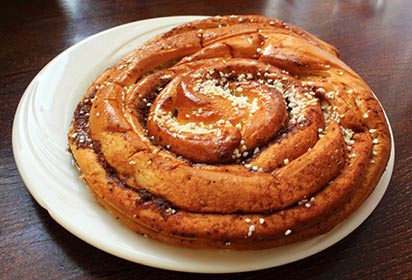Breathe the fresh air scented with pine and relish the unspoilt nature; this is what west Sweden is all about.
James Proctor, author of West Sweden: The Bradt Guide
With miles of pristine coastline dotted with thousands of tiny islands, west Sweden offers visitors a chance to see nature at its wildest. Sample oysters and mussels straight from the sea in Lysekil or delve into the hidden corners of the archipelago by sea kayak.
Meander through the elegant boulevards and canals of cosmpolitan Gothenburg or head inland to camp and canoe in the vast wilderness of Dalsland.
Food and drink in West Sweden
Top 5 restaurants in Gothenburg
Bhoga The finest of Scandinavian ingredients. One Michelin star.
Bord 27 Family-owned restaurant with sensible prices.
Familjen Stylish European brasserie.
Gabriel Succulent fresh fish.
Koka Inventive modern Swedish cuisine. One Michelin star.
Top 5 cafés in Gothenburg
Alkemisten A favourite among coffee connoisseurs.
Bar Centro The best cappuccino in town.
Da Matteo Urban chic with outdoor courtyard.
Kafe Magasinet Organic & fairtrade.
Rosenkaféet Garden café surrounded by roses.
Top 5 places to eat on the Bohuslän Coast
Brygghuset Waterside dining in a stunning location.
Grand Hotel Marstrand Old-world elegance overlooking the sea.
Kosters Trädgårdar Organic treats.
Vatten Restaurang & Kafé Inside the Nordic Watercolour Museum.
Villa Sjötorp Classic seafood dishes are a speciality.
When to visit West Sweden
The summer months from June to August are always the best time to visit Sweden with long, sunny days and white nights, though be warned that July can be very busy with holidaying Swedes! May and September/October can be pleasant, too, if the weather’s playing along. Winter, though, is an altogether different matter: daylight is in short supply and there’s often snow on the ground from November through until April; temperatures can fall to -10°C, although on the coast it’s usually milder. Full climate and weather facts can be found at www.smhi.se.
What to see and do in West Sweden
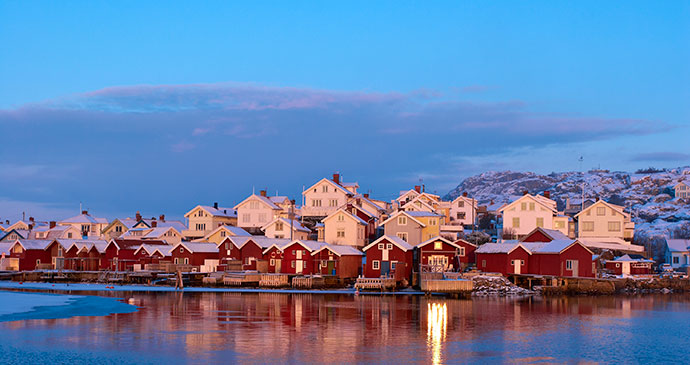 Bohuslän in winter © Jonas Inman, vastverige.com
Bohuslän in winter © Jonas Inman, vastverige.com
Bohuslän Coast
Without a doubt, the Bohuslän coast is one of Sweden’s most enchanting and alluring regions. As you’d expect, the landscape is dominated by the sea: this is a region of rocky bluffs, cliffs, islands and skerries that stretches for 160km from Gothenburg to the Norwegian border.
Yet what makes this deeply indented coastline, punctuated with no fewer than 8,000 islands, so special is the unusual colouring of the rock – pink. Known as Bohus granite, the rock bears a distinctly pink hue and is found extensively between Fjällbacka and Lysekil, often running in linear formation a little off the coast. Naturally, small fishing communities grew up around the numerous natural harbours and herring, in particular, remained the region’s lifeblood until the early 1900s.
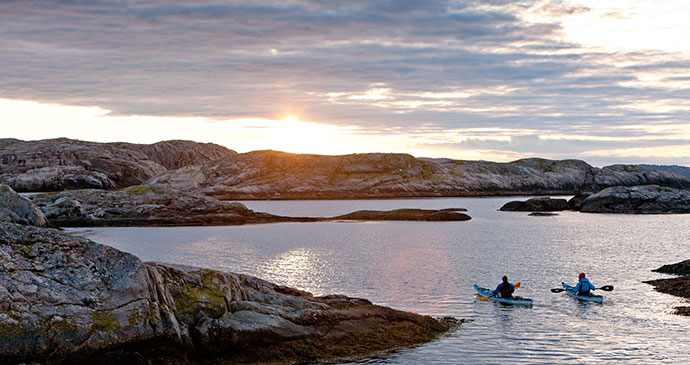 Take to the water in a sea kayak and explore the coast’s uninhabited islets and islands at your own pace © Henrik Trygg, West Sweden Tourist Board
Take to the water in a sea kayak and explore the coast’s uninhabited islets and islands at your own pace © Henrik Trygg, West Sweden Tourist Board
Today, though, Bohuslän is known for its succulent seafood: mussels, oysters, lobsters, langoustines, crabs and prawns all thrive in the deep, cold and exceptionally clean waters off the Swedish west coast. The cold waters cause the crustaceans to grow more slowly than in warmer climates, which consequently produces an exceptional taste. A trip up the coast offers the opportunity to see and sample mussels and oysters in their natural habitat on board a ‘seafood safari’; alternatively, take to the water in a sea kayak and explore the coast’s uninhabited islets and islands at your own pace; or head out to any of the larger islands for a spot of island hopping, or simply cycle along quiet country lanes out to the beach and laze in the summer sunshine.
Inland, Bohuslän offers a range of diversions: everything from stunning Bronze Age rock carvings – the greatest concentration of carvings located anywhere in Scandinavia – to a superb wildlife sanctuary and marine park housing some of the world’s most endangered species. Quite simply, Bohuslän is West Sweden at its best.
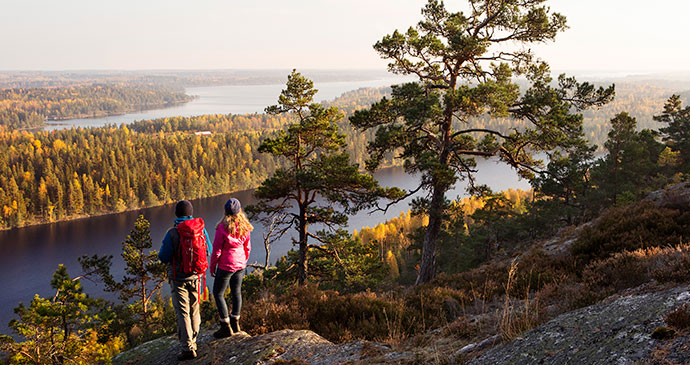 Dalsland’s hilly terrain offers outdoor enthusiasts spectacular panoramas © Roger Borgelid, vastverige.com
Dalsland’s hilly terrain offers outdoor enthusiasts spectacular panoramas © Roger Borgelid, vastverige.com
Dalsland
Sandwiched between Bohuslän to the west and Lake Vänern to the east, the province of Dalsland is West Sweden at its most rural. Sparsely populated, Dalsland is truly a land of lakes and forests; there are few towns here and the only settlement of any size, uneventful Åmål, located in the far northeast of the region, sees few visitors.
But nobody comes to Dalsland for its towns – instead the area is known for its great range of outdoor activities which make full use of the unspoilt nature which abounds here: fishing, kayaking, horseriding, hiking, even pedalling a railbike along disused railway tracks are all popular. Dalsland is also the location for one of the region’s latest and most unusual attractions: a stay in a cabin made of glass, rather than wood, allowing you to completely surround yourself by the sights and sounds of Swedish nature. Indeed, the cuisine here takes its cue from the great outdoors, too: game, freshwater fish, berries and mushrooms all feature prominently on the menu.
The place to aim for is Dals-Långed, a small village roughly in the centre of the province, from where you’re within easy reach of the main attractions – and also one of the most idyllic places to stay. If, however, you’re looking for something less energetic, head for Bengtsfors, a modest little place in the north of Dalsland, from where you can take a boat trip along the graceful Dalsland Canal, with its 30-odd locks, down to Håverud where you’ll find Sweden’s one-and-only aqueduct.
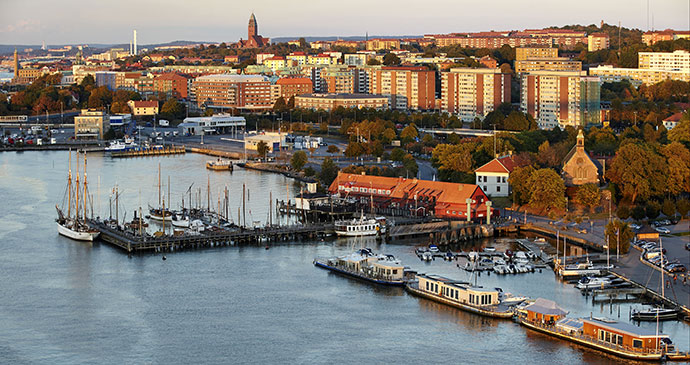 The busy harbour entrance of Gothenburg © Kjell Holmner, vastsverige.com
The busy harbour entrance of Gothenburg © Kjell Holmner, vastsverige.com
Gothenburg
Dominating the entire west coast of Sweden, handsome Gothenburg (Göteborg) is an instantly likeable place. The city, Sweden’s second largest with a population today of around half a million, was actually designed by the Dutch, world experts in the early 1600s in draining and building on marshland. By order of the Swedish king, the Dutch dug a total of four canals to channel water into the Göta river – two of them remain. Indeed, Gothenburg’s layout of streets and canals bears a striking resemblance to that of the Indonesian capital, Jakarta, which was also built by the Dutch at the same time. Founded in 1621 and occupying a prime location on the shores of the Kattegatt (an arm of the North Sea), at the mouth of the Göta river, Gothenburg has traditionally sought its fortunes through sea-borne trade. The Swedish East India Company, established a century or so later in 1731, generated considerable wealth through commercial links, particularly with China.
Many of the city’s imposing classical stone buildings, often lining the canals, were built around this time; one fine example is Ostindiska Huset, which once served as the company’s headquarters. Over the centuries, a succession of Dutch, German and Scottish merchants settled in Gothenburg – sometimes founding commercial dynasties, sometimes simply securing a proportion of the city’s lucrative trade for themselves. Gothenburg has always been an international city, and that cosmopolitan spirit lives on today.
Central Gothenburg can be divided into three main areas: the grid of streets between the Göta river and Centralstation, which lie north of the Stora Hamnkanalen canal; the shopping streets south of the canal, located between the Trädgårdsföreningen park and the river; and the area south of Kungsportsplatsen square, dominated by Avenyn, the city’s main boulevard. Out of the centre, there are again three main areas worthy of exploration: studenty Vasastaden, west of Avenyn, with its fine 19th-century and National Romantic architecture; the former working-class district of Haga, west of Vasastaden, now a haven of trendy cafés and restaurants; and, finally, Linné, west and south of Haga, which includes the glorious Slottsskogen park and botanical gardens.
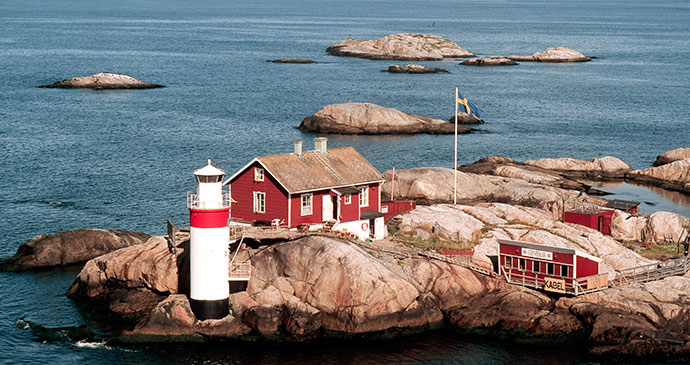 The Gothenburg Archipelago is dotted with thousands of tiny islands © Jorma Valkonen, vastsverige.com
The Gothenburg Archipelago is dotted with thousands of tiny islands © Jorma Valkonen, vastsverige.com
Gothenburg Archipelago
No matter whether you arrive in Gothenburg by ferry or by plane, you can’t fail to spot the array of coastal islands which lie just off the city’s southwestern peninsula. The southern part of the archipelago is the easiest to get to and is a favourite summer playground for holidaying Gothenburgers – and for good reason. Not only are the islands easy and inexpensive to reach, they offer some of the city’s best beaches and sunbathing opportunities. Perhaps best of all, though, they are car-free: transport on the islands is by bike or motorised three-wheeler mopeds which are used for deliveries. Accordingly, the pace of life out in the archipelago is enviably sedate – a trip to any of the islands offers a rare chance to slow down and take it easy: cycle down winding lanes decked with wild roses, stroll through leafy woodlands or lay out your towel on the smooth rocks which line these shores and soak up the summer sunshine. Connections to the mainland are frequent and reliable, making it perfectly feasible to spend the night in the archipelago in a hotel or guesthouse should you choose to do so.
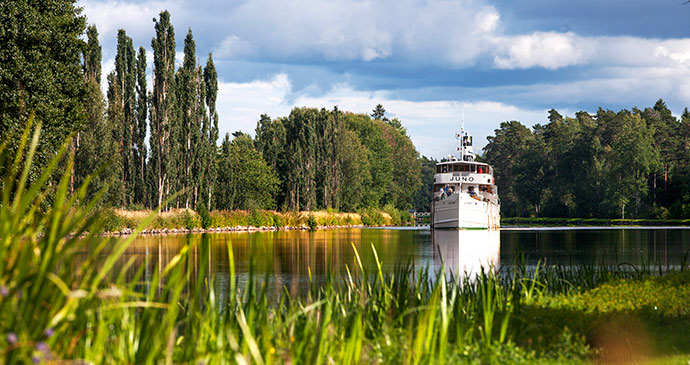 Drift down the Göta Canal on the ferry Juno © Åsa Dahlgren, vastverige.com
Drift down the Göta Canal on the ferry Juno © Åsa Dahlgren, vastverige.com
The Göta Canal and Around
The most beguiling stretch of the canal lies between the great lakes of Vänern and Vättern in the province of Västergötland – a leisurely boat trip or cycle ride between Sjötorp and Töreboda is a great way to see the canal and the surrounding countryside. For an overnight stop, look no further than the converted mill at Norrqvarn, right alongside the canal, where there’s an accomplished restaurant, too.
At Karlsborg, on the western shores of Lake Vättern, you can get to grips with Swedish military history and explore the impressive fortress which was designed to protect Sweden from a possible military invasion during the 19th century. West Sweden’s rich industrial heritage is on display in nearby Forsvik where you can visit a converted foundry and paper mill.
Nature lovers are well served, too: Tiveden National Park, north of the canal, boasts a protected area of virgin forest, one of the few in the entire region, and a network of hiking trails provides ready access on foot to some of the giant boulders and deep ravines for which the park is also justifiably known.
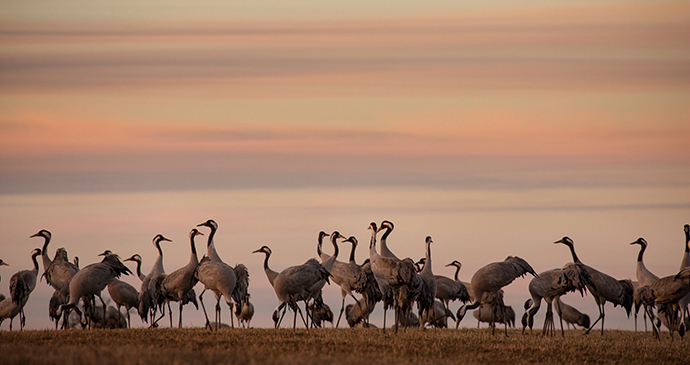 Birdwatchers will delight at the crane spectacles that take place each spring at Hornborgasjön © Roger Borgelid, vastverige.com
Birdwatchers will delight at the crane spectacles that take place each spring at Hornborgasjön © Roger Borgelid, vastverige.com
Västergötland
Covering a vast area of nearly 17,000km2, the province is roughly the same size as Wales, with few large towns or cities. It’s at its most appealing in lakeside Lidköping, where the nearby hilly plateau of Kinnekulle affords spectacular views over the sweeping expanses of Lake Vänern.
Moving to the southeast, Varnhem with its magnificent abbey, resting place of one of Sweden’s greatest statesmen, Birger Jarl, offers easy access to the remarkable prehistoric burial ground, Ekornavallen, with remains dating from the Stone Age to late Iron Age.
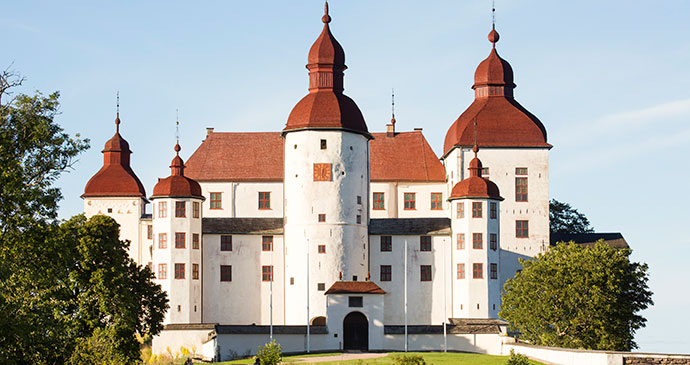 Fans of Baroque splendour will be enchanted by Läckö Slott, a 17th-century castle, just to the north of the town © Roger Borgelid, vastverige.com
Fans of Baroque splendour will be enchanted by Läckö Slott, a 17th-century castle, just to the north of the town © Roger Borgelid, vastverige.com
Close by, the ornithologist’s dream, Hornborgasjön (Lake Hornborga) attracts up to 18,000 cranes every spring which come here to pair – dancing all day long in the process and making quite an extraordinary sight. Västergötland’s main city outside Gothenburg is Borås, a bright and breezy place, which attempts to charm visitors through its rich industrial heritage. One of West Sweden’s real historical gems, the medieval castle, Torpa stenhus, lies close by and should be on everyone’s lists of must-sees.
Pretty, little Alingsås is also worth seeking out – there are more cafés here than you can shake a teaspoon at and the town makes a perfect place for a fika, the quintessential Swedish pastime of drinking coffee and savouring cinnamon buns and princess cake.
Related books
For more information, see our guide to West Sweden:
Related articles
Stretching from Gothenburg to the Norwegian border, the west coast is one of Sweden’s most enchanting destinations.
West Sweden has plenty of culture and activities to offer.
Kelly Randell explains how to make the perfect Swedish cinnamon bun.
Find the perfect coffee and kanelbullar with our walking tour of Gothenburg.
